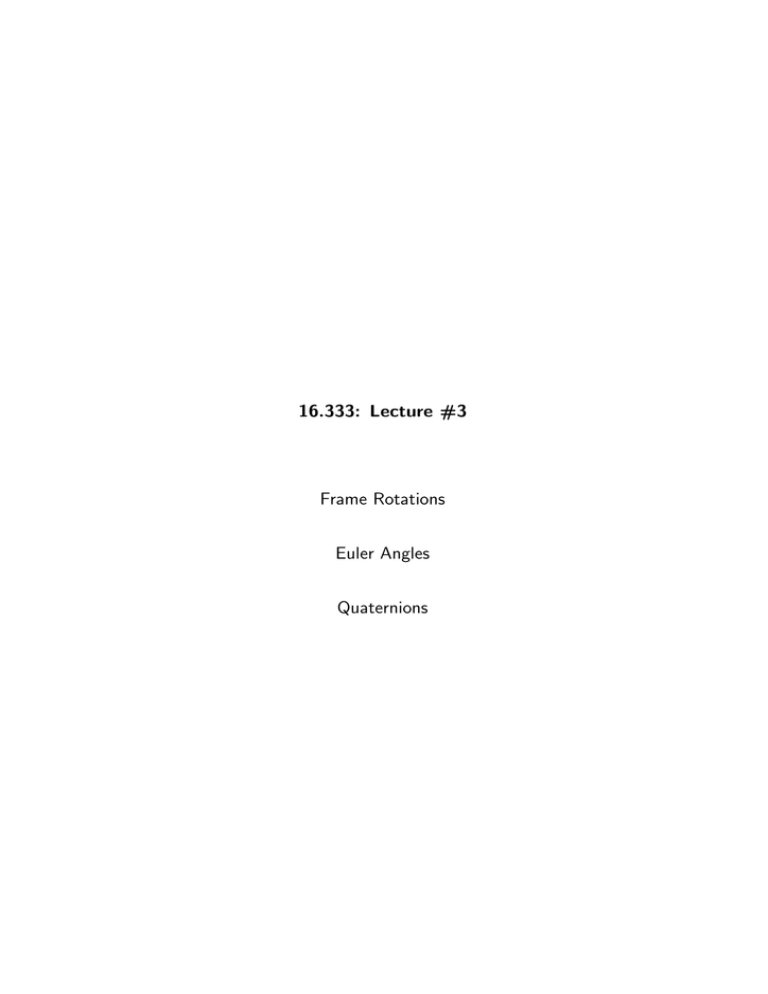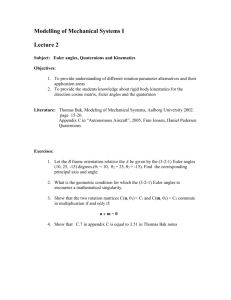16.333: Lecture #3 Frame Rotations Euler Angles Quaternions
advertisement

16.333: Lecture #3 Frame Rotations Euler Angles Quaternions Fall 2004 16.333 3–1 Euler Angles • For general applications in 3D, often need to perform 3 separate rotations to relate our “inertial frame” to our “body frame” – Especially true for aircraft problems • There are many ways to do this set of rotations ­ with the variations be based on the order of the rotations – All would be acceptable – Some are more commonly used than others • Standard: start with the body frame (x, y, z) aligned with the inertial (X, Y, Z), and then perform 3 rotations to re­orient the body frame. ①Rotate by ψ about Z ⇒ x� , y � , z � ②Rotate by θ about y � ⇒ x�� , y �� , z �� ③Rotate by φ about x�� ⇒ x, y, z Euler angles: – ψ ∼ Heading/yaw – θ ∼ Pitch – φ ∼ Roll Fall 2004 16.333 3–2 • Can write these rotations in a convenient form: ⎤ ⎡ ⎤⎡ ⎤ ⎡ ⎤ x� cψ sψ 0 X X ⎣ y � ⎦ = ⎣ −sψ cψ 0 ⎦ ⎣ Y ⎦ = T3(ψ) ⎣ Y ⎦ z� 0 0 1 Z Z ⎡ ⎤ ⎡ ⎤⎡ � ⎤ ⎡ �⎤ x�� cθ 0 −sθ x x ⎣ y �� ⎦ = ⎣ 0 1 0 ⎦ ⎣ y � ⎦ = T2(θ) ⎣ y � ⎦ z �� sθ 0 cθ z� z� ⎡ ⎤ ⎡ ⎤ ⎡ �� ⎤ ⎡ �� ⎤ x 1 0 0 x x ⎣ y ⎦ = ⎣ 0 cφ sφ ⎦ ⎣ y �� ⎦ = T1(φ) ⎣ y �� ⎦ z 0 −sφ cφ z �� z �� ⎡ which combines to give: ⎡ ⎤ ⎡ ⎤ x X ⎣ y ⎦ = T1(φ)T2(θ)T3(ψ) ⎣ Y ⎦ z Z ⎡ ⎤⎡ ⎤ cθcψ cθsψ −sθ X = ⎣ −cφsψ + sφsθcψ cφcψ + sφsθsψ sφcθ ⎦ ⎣ Y ⎦ sφsψ + cφsθcψ −sφcψ + cφsθsψ cφcθ Z • Note that the order that these rotations are applied matters and will greatly change the answer – matrix multiplies of Ti must be done consistently. Fall 2004 16.333 3–3 • To get the angular velocity in this case, we have to include three terms: ①ψ̇ about Z ②θ̇ about y � ③φ̇ about x�� which we combine to get ω � • Want to write ω � in terms of its components in final frame (body) – Use the rotation matrices • Example: rotate ψ̇ about Z ≡ z � ⎡ ⎤ 0 – In terms of X, Y, Z, frame rotation rate has components ⎣ 0 ⎦, ψ̇ which is the same as in frame x�, y �, z � – To transform a vector from x�, y �, z � to x, y, z, need to use T1(φ)T2(θ) ⎡ ⎤ 0 – Similar operation for θ̇ about y � ≡ y �� ⇒ use T1(φ) on ⎣ φ̇ ⎦ 0 • Final result: ⎡ ⎤ ⎡ ⎤ ⎡ ⎤ ⎡ ⎤ 0 0 ωx φ̇ ωb = ⎣ ωy ⎦ = T1(φ)T2(θ) ⎣ 0 ⎦ + T1(φ) ⎣ θ̇ ⎦ + ⎣ 0 ⎦ ωz ψ̇ 0 0 Fall 2004 16.333 3–4 • Visualization: Can write �˙ ω � = �φ˙ + �θ̇ + ψ �˙ do not form a mutually ˙ �θ, ˙ ψ But �φ, orthogonal triad Need to form the orthogonal projec­ tions onto the body frame x, y , z ⎡ ⎤ ⎡ ⎤ ⎡ ⎤ ⎡ ⎤ 0 0 ωx φ̇ ωb = ⎣ ωy ⎦ = T1(φ)T2(θ) ⎣ 0 ⎦ + T1(φ) ⎣ θ̇ ⎦ + ⎣ 0 ⎦ ωz ψ̇ 0 0 • Final form ωx = φ˙ − ψ̇ sin θ ωy = θ̇ cos φ + ψ˙ cos θ sin φ ωz = −θ̇ sin φ + ψ˙ cos θ cos φ • With inverse: φ̇ = ωx + [ωy sin φ + ωz cos φ] tan θ θ̇ = ωy cos φ − ωz sin φ ψ̇ = [ωy sin φ + ωz cos φ] sec θ Fall 2004 16.333 3–5 • Need to watch for singularities at |θ| = ±90◦ • If we limit 0 ≤ ψ ≤ 2π π π − ≤ θ ≤ 2 2 0 ≤ φ < 2π then any possible orientation of the body can be obtained by per­ forming the appropriate rotations in the order given. • These are a pretty standard set of Euler angles Fall 2004 Quaternions 16.333 3–6 • Theorem by Euler states that any given sequence of rotations can be represented as a single rotation about a single fixed axis • Quaterions provide a convenient parameterization of this effective axis and the rotation angle ⎡ ⎤ b1 � ⎢ ⎥ � E sin ζ/2 ⎢b ⎥ b = ⎢ 2 ⎥ = cos ζ/2 ⎣ b3 ⎦ b4 where E is a unit vector and ζ is a positive rotation about E • Notes: – �b� = 1 and thus there are only 3 degrees of freedom in this formulation as well – If b represents the rotational transformation from the reference frame a to reference frame b, the frame a is aligned with frame b when frame a is rotated by ζ radians about E • In terms of the Euler Angles: sin θ = −2(b2b4 + b1b3) � � φ = arctan 2 2(b2b3 − b1b4), 1 − 2(b21 + b22) � � 2 2 ψ = arctan 2 2(b1b2 − b3b4), 1 − 2(b2 + b3) • Pros: – Singularity free; Computationally efficient to do state propagation in time compared to Euler Angles • Cons: – Far less intuitive ­ less appealing • Refs: Kuipers, Quaternions and rotation sequences, 1999 Princeton University Press.







